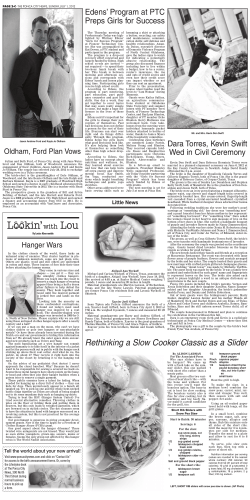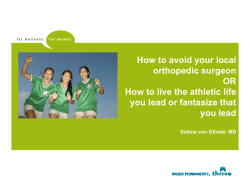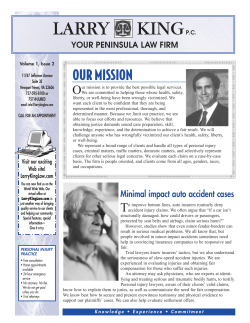
An Unusual Case of Child Head Injury by Coat Hanger* CASE REPORT
J Forensic Sci, September 2008, Vol. 53, No. 5 doi: 10.1111/j.1556-4029.2008.00820.x Available online at: www.blackwell-synergy.com CASE REPORT Biagio Solarino,1 M.D.; Kathy Reckentwald,2 R.N.; and Amy M. Burrows-Beckham,2 M.D. An Unusual Case of Child Head Injury by Coat Hanger* ABSTRACT: Traumatic brain injury is the leading cause of morbidity and mortality among children suspected of child abuse. Penetrating cranio-facial injuries are generally rare in the pediatric age group and are caused by both accidental and inflicted mechanisms. We report an unusual case of a 2-year-old female who was admitted to a pediatric emergency room with an industrial stainless steel coat hanger impaled in her skull. Pertinent clinical forensic medicine examination, coupled with home inspection and interviews by the local law enforcement, revealed a horrible episode of domestic violence. KEYWORDS: forensic science, coat hanger, penetrating cranio-facial injuries, child abuse The question of accidental versus inflicted injuries is the central issue involved in an investigation for detecting child abuse or neglect. Clinical forensic medicine (CFM) is the application of appropriate forensic practices and principles, heretofore reserved for use by the pathologist, at autopsy, to living patients in a clinical setting (1). A CFM team, comprised of physicians and nurses trained in forensic pathology, serve as part of a multidisciplinary team in the investigation of alleged child abuse. The CFM team evaluates many types of injuries in children and adults, including blunt force injuries. Blunt impact cranio-facial injuries can result from a blow to the head with a fist or other objects inflicted by a perpetrator, although injuries affecting specific frontal locations such as the forehead, nose, chin and other ‘‘bony prominences’’ are often the result of accidental events secondary to children playing or trivial falling. The physical findings in the infant or child must be correlated with the history provided by the caretaker, as well as milestones achieved by the presumptive victim and law enforcement’s crime scene investigations and interviews. We report a case of a child examined by the CFM team, who presented with a penetrating frontal injury caused by a stainless steel hanger. All ‘‘forensic’’ features of this case are described. Case Report A 2-year-old female was taken by medical helicopter from a rural hospital to a pediatric emergency department with a large stainless steel hanger embedded in her left frontal region, between the orbit and the bridge of the nose (Fig. 1). The child’s mother was interviewed by members of the CFM team. She stated the day of this event began as a usual day. At 6:30 am, a friend dropped off her 21-month-old child for the victim’s mother to baby sit. The mother 1 Section of Legal Medicine (DI.M.I.M.P.), University of Bari, Piazza Giulio Cesare 11, 70124 Bari, Italy. 2 Division of Forensic Pathology and Clinical Forensic Medicine, University of Louisville School of Medicine, Office of the Chief Medical Examiner, 810 Barrett Avenue, Louisville, KY 40204-1702. *Presented at the 58th Annual Meeting of the American Academy of Forensic Science in Seattle, WA, February 20–25, 2006. Received 24 Feb. 2007; and in revised form 4 Nov. 2007 and 11 Jan. 2008; accepted 28 Jan. 2008. 1188 and the father of the victim, the victim, and the friend’s child were the only occupants of the apartment. The mother and the children got out of bed at 8:30. Upon arising, the victim’s mother began putting clothes away in the bedroom where the victim’s father was trying to sleep. The mother admitted the father was mumbling and mad at her. She left the bedroom and shut the door behind her. While she had her back to the door, the father opened the door and threw a hanger at her. She felt the hanger fly by her, and turned to look toward the father. When she turned back around, she noticed the hanger had hit her daughter’s head and her daughter had fallen forward. The mother yelled ‘‘The hanger is in her head!’’ The father picked up the child and ran outside to seek assistance. The unmarried mother (19 years old) and father (20 years old) have a history of domestic violence in their 5-year relationship, consisting of verbal and physical abuse. They reported no history of alcohol or drug abuse. The violence had been directed at each other, but not the child, until this event. Initially, the mother stated the injury was the result of an accidental fall off the couch. Later, the father admitted to having thrown a hanger, with the intention of hitting the mother. Instead, the hanger hit his daughter, who was playing on the floor. In the emergency department, the child was conscious, alert, and moved all extremities. A large stainless hanger was impaled between the left orbit and the bridge of the nose. The wound was actively bleeding. A lateral radiograph of the head (Fig. 2) demonstrated a foreign body imbedded in the frontal region of the skull for c. 2 cm. A CT scan of the head showed a U-shaped body entering the frontal bone, to the left of the midline, with probable fractures of the cribriform plate and crista galli, a small interhemispheric subdural hemorrhage and a left frontal subdural pneumocephalus. There was no injury to the left globe or nasolacrimal duct. The hanger was cut with wire cutters before the child was taken to the operating room where a bifrontal craniotomy was performed. The curved part of the hanger was removed and the injured brain was dbrided. The ethmoid bone and shredded galea were repaired. Three days later she was noted to be hemodynamically stable, awake, and alert with no speech or language impairment. On postoperative day 5, the child was discharged to home with a Child Protective Services (CPS) approved caretaker. 2008 American Academy of Forensic Sciences SOLARINO ET AL. • UNUSUAL CASE OF CHILD HEAD INJURY 1189 The findings of the physical examination, the scene investigation with interviews of the parents, and the reconstruction of the incident support the conclusion that the injury to the child was inflicted. Now the child is doing well, living with mom and a sibling that mom got pregnant with around the time of this incident. Discussion FIG. 1—Stainless coat hanger embedded in victim’s left frontal region. FIG. 2—Lateral radiograph of the head with penetrating foreign body in the skull. The child underwent a CFM examination 1 and 4 days after being admitted to the hospital. She had no significant past medical history per medical records. On physical examination, she demonstrated a bandaged incision on the left aspect of the forehead and healing bifrontal craniotomy incisions. Periorbital ecchymoses was present on the left. Examination of the trunk and extremities demonstrated several linear scabbed abrasions on bilateral knees. On the anterior aspect of the right leg, in the middle one-third, was a scabbed abrasion with surrounding brown contusion. Further additional information on the hanger was collected. The tool was a large caliber, stainless steel hanger measuring c. 4 by 4 mm in thickness, while the U-shaped angle measured c. 3 cm. Traumatic head injury is the leading cause of mortality and disability in children physically abused. According to the literature, nearly 80% of total child abuse deaths result from or involve blunt head trauma inflicted with a fist or other tool, or by throwing a child such that the head impacts a surface (2–8). The type and site of craniocerebral damage resulting from reported mechanisms of injury are useful in distinguishing accidental from abusive injuries. In very young children, trivial falls or playing are the predominant causes of head injuries and rarely warrant medical attention. In infants and toddlers, accidental facial injuries are typically located on the forehead, zygoma, and other bony prominences (9,10). Nondisplaced linear skull fractures may occur in accidental falls of < 4 feet (11). Craniofacial penetrating trauma by foreign objects represents a small fraction of traumatic brain injury in the pediatric age group (12). Children < 2–3 years of age falling onto blunt household items are at greater risk to sustain these types of injuries (13,14). In the world literature, other papers have presented cases in which a child’s skull is penetrated by objects such as metal rods or wires, chopsticks, wooden branches, an electric plug, and glass (13,15–19). The skull of a young child is incompletely ossified until c. 2 years of age, so they are at greater risk for penetrating injury to the bone and dura caused by lowvelocity foreign objects (12–14). The maxillary sinuses, the ethomoid sinuses, and the orbits are at particular risk for penetrating injury, while the frontal and sphenoid sinuses are only occasionally involved (20). The severity of the injury is mainly dependent on the site and depth of the penetration. Frontal penetrating injuries are accompanied by the lowest rates of morbidity and mortality (18). Coat hanger injuries are very uncommon. A search of the world literature yielded only two other reported cases. In one case, the hook of the hanger penetrated the nose of a child (21). In the other case, the hook of the hanger penetrated the floor of the mouth of a 60-year-old woman (22). Both cases were unintentional craniofacial trauma. In our case, a multidisciplinary team investigation, comprised of physicians and nurses trained in forensic pathology, made it possible to determine the injuries suffered by this child were a consequence of an episode of domestic violence. The CFM team usually evaluates many types of injuries in children and adults, including blunt force injuries. For such ‘‘living’’ wounds, it is important to emphasize the role of the medical examiner who can apply his knowledge of injury patterns gleaned from postmortem examination. Initially in the investigation, the mother stated the child fell off the couch onto the hanger, while she was playing. After examination by the CFM team, coupled with home inspection and interviews by the local law enforcement, both parents, who are not married, reported that baby’s head injury was secondary to an attempt by the father to hit the wife while they were arguing. The investigators were uncertain whether the hanger was thrown from several feet across the room or whether it was directly applied to the child’s skull. 1190 JOURNAL OF FORENSIC SCIENCES Experiments conducted by the police, using a similar hanger and double-up pieces of cardboard, demonstrated the U-shaped portion of the hanger penetrated the cardboard 6 inches deep or more, when thrown from the same distance the father stated he was from the child. The crime scene investigation pointed out that there were other hangers on the floor, manufactured of plastic material, and the one used was the only stainless steel, large caliber hanger present in the room (23). The findings of the physical examination, the scene investigation with interviews of the parents, and the reconstruction of the incident support the conclusion that the injury to the child was inflicted. In conclusion, diagnosing child abuse is a complicated issue. When the injuries are uncommon and involve specific parts of the body, such as the frontal plane, the examiner has to eliminate the potential of an accident. The combined efforts of a multidisciplinary team serve a primary role in the management of domestic violence and child abuse cases. References 1. Smock WS. Clinical forensic medicine. Louisville Med 1997;44(12): 535–7. 2. Giardino AP, Alexander R. Child maltreatment. A clinical guide and reference, 3rd rev. St Louis: G.W. Medical Publishing, Inc, 2005. 3. Di Maio VJM, Di Maio D. Forensic pathology, 2nd ed. New York: CRC Press LLC, 2001. 4. Corey TS, Collins KA. Pediatric forensic pathology. In: Stocker JT, Dehner LP, editors. Pediatric pathology, 2nd ed. Philadelphia, PA: Lippincott Williams and Wilkins, 2001;247–82. 5. Case ME, Graham MA, Handy TC, Jentzen JM, Monteleone JA. National Association of Medical Examiners Ad Hoc Committee on Shaken Baby Syndrome. Position paper on fatal abusive head injuries in infants and young children. Am J Forensic Med Pathol 2001;22(2):112–22. 6. DiScala C, Sege R, Li G, Reece RM. Child abuse and unintentional injuries: a 10-year retrospective. Arch Pediatr Adolesc Med 2000;154(1):16–22. 7. Billmire ME, Myers PA. Serious head injury in infants: accident or abuse? Pediatrics 1985;75(2):340–2. 8. Bruce DA, Zimmerman RA. Shaken impact syndrome. Pediatr Ann 1989;18(8):482–94. 9. Reece RM, Sege R. Childhood head injuries: accidental or inflicted? Arch Pediatr Adolesc Med 2000;154(1):11–5. 10. Sugar N, Taylor J, Feldman K. Bruises in infants and toddlers: those who don’t cruise rarely bruise. Puget Sound Pediatric Research Network. Arch Pediatr Adolesc Med 1999;153(4):399–403. 11. Lyons TJ, Oates RK. Falling out of bed; a relatively benign occurrence. Pediatrics 1993;92:125–7. 12. Koestler J, Keshavarz R. Penetrating head injury in children: a case report and review of the literature. J Emerg Med 2001;21(2):145–50. 13. Tan MH, Choudhari KA. Penetrating head injury from an electrical plug. Injury 2003;34(12):950–3. 14. O’Loughlin M, Criddle L. A case of penetrating head trauma in an 8-month-old. J Emerg Nurs 2003;29(2):189–90. 15. Regev E, Constantini S, Pomeranz S, Sela M, Shalit M. Penetrating craniocerebral injury caused by a metal rod: an unusual case report. Injury 1990;21(6):414–5. 16. Matsumoto S, Hasuo K, Mizushima A, Mihara F, Fukui M, Shirouzu T, et al. Intracranial penetrating injuries via the optic canal. AJNR Am J Neuroradiol 1998;19(6):1163–5. 17. Park SH, Cho KH, Shin YS, Kim SH, Ahn YH, Cho KG, et al. Penetrating craniofacial injuries in children with wooden and metal chopsticks. Pediatr Neurosurg 2006;42(3):138–46. 18. Lopez Gonzalez A, Gutierrez Marin A, Alvarez Garijo JA, Vila Mengual M. Penetrating head injury in a paediatric patient caused by an electrical plug. Childs Nerv Syst 2006;22(2):197–200. 19. Gray J, Molloy D, Jenkins MG. Glass in a scalp laceration: an unusual case of penetrating head injury presenting to the emergency department. Eur J Emerg Med 2004;11:117–8. 20. Al-Sebeih K, Karagiozov K, Jafar A. Penetrating craniofacial injury in a pediatric patient. J Craniofac Surg 2002;13(2):303–7. 21. Moustafa MH, Ho MR. Coat hanger tip injury. J Emerg Med 1999;17(4):735. 22. Kaushik V, Kawaja S, Bhalla RK, Pahade A. Coat hanger injury. J Emerg Med 2005;29(4):477–8. 23. Pence D, Wilson C. The role of law enforcement in response to child abuse and neglect. Washington, DC: US Dept of Health and Human Services, National Center on Child Abuse and Neglect, 1992. Additional information and reprint requests: Biagio Solarino, M.D. Sezione di Medicina Legale (DI.M.I.M.P.) Universit Degli Studi di Bari Piazza Giulio Cesare 11 70124 Bari Italy E-mail: [email protected]
© Copyright 2025
















